语言学课件 phonology
- 格式:pdf
- 大小:131.80 KB
- 文档页数:10
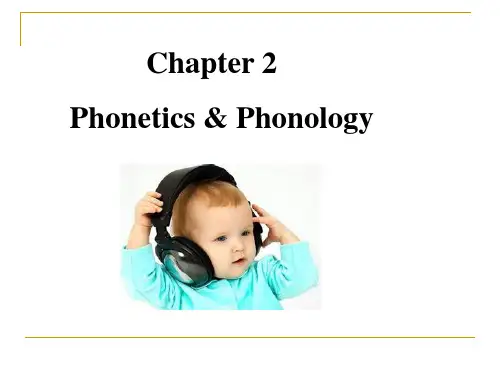
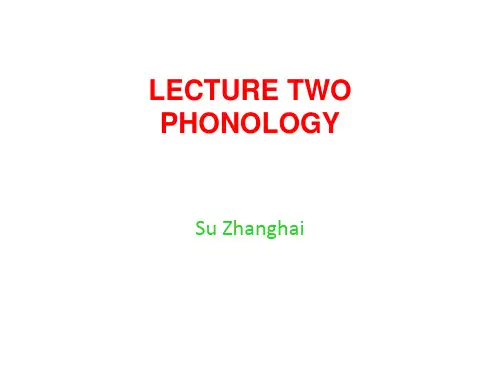




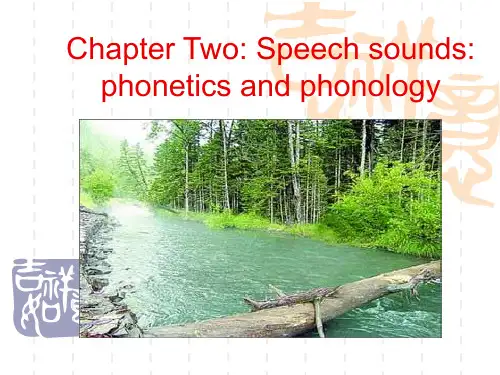
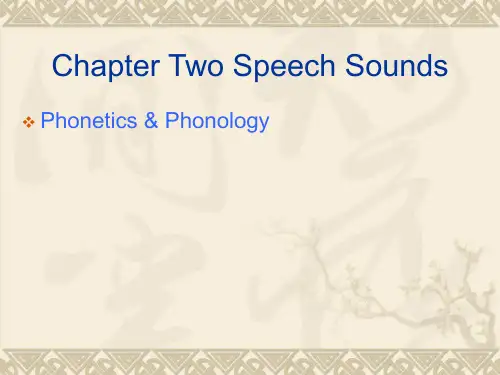

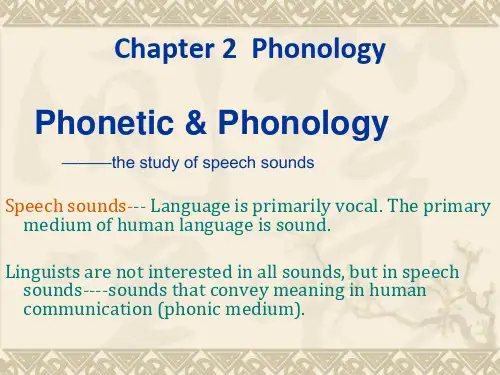
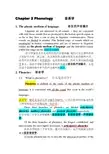
Chapter 2 Phonology 音系学1.The phonic medium of language 语言的声音媒介Linguists are not interested in all sounds ;they are concerned with only those sounds that are produced by the human speech organs in so far as they have a role to play in linguistic communication .These sounds are limited in number .This limited range of sounds which are meaningful in human communication and are of interest to linguistic studies are the phonic medium of language ;and the individual sounds within this range are the speech sounds.语言学家也并不是对所有的声音感兴趣,他们只关注那些在语言交际中占有一席之地、由人类的发音器官所发出来的那些声音。
这些声音在数量上是有限的。
这些范围有限,但对人类交际活动意义重大、对语言学研究价值不菲的声音就是语言的声音媒介,凡是在这个范围的每个单个的声音都叫做语音。
2.Phonetics 语音学2.1What is phonetics? 什么是语音学?language; it is concerned with all the sound that occur in the world’s languages.上所有的语言中出现过的一切声音。
These three branches of phonetics are labeled articulatory phonetics, auditory phonetics, and acoustic phonetics respectively.语音学的三个分支分别被称为发音语音学,听觉语音学和声学语音学。
Phonology(音位学)Phonetics is a study of the production,transmission and perception of speech sounds, and their physical properties.Phonemes音位are the minimal distinctive units in the sound system of a language. Allophones 音位变体are the different realizations of a particular phoneme in a language. Phones are the smallest identifiable phonetic unit or segment in a stream of speech.Minimal pair最小对立体:a pair of words which differ from each other by one sound.3 conditions: 1 the two forms are different in meaning; 2 the two forms are different in one segment; 3 the different sounds occur in the same position of the two words: teach---cheat, read—dearIf two or more sounds never appear in the same enviornment, that is, each sound only appears in the enviornment where the other never occurs, they are in complementary distribution.互补分布pen—pet, pat—spat—tap, lead—realIf two or more sounds can occur in the same environment and the substitution of one sound for another brings about a change of meaning, they are in contrastive distribution.Will—till 对比分布When two sounds can appear in the same environment and the substitution of one for the other does not cause any change in meaning, they are in free variation. 自由变体A distinctive feature区别性特征is one which distinguishes one phoneme from another,like /nasal/,/voiced/. put forward by Jakobson.The assimilation rule同化原则the effect of phonetic context or situation on a particular phone.Deletion rule删除: delete a sound although it is orthographically represented Sequential rules顺序:state the possible combination of phonemes and the constraints over such a combination for a language.suprasegmental features(超切分特征) features that have effect on more than one segment, which also known as prosody(韵律语音特征): stress, tone, intonation and juncture.stress(重音,重读) some nouns are stressed on the first syllables while the verbs are stressed on the second syllables:Tone(声调): the level of pitch that is used in a linguistically contrastive ways.Tone language: ma ma ma ma(妈,麻马骂)Intonation(语调) 5 intonations: the falling tones: certainty; the rising tones: uncertainty, the level tones: undecided yet whether known or unknown,juncture(连音): the boundary features that may demarcate grammatical units:A name an aimnarrow transcription(严式音标):symbolizes all the possible speech sounds, broad transcription(宽式音标): transcribes or indicates only the only those speech sounds that distinguish one word from another in a language . It is phonemic.。
24.900 Introduction to Linguistics4/6/05PhonologyNB: Quiz date has been changed to 4/20/05. It will cover only phonetics and phonology. Topics for today’s class:1.Review of vowels2.Syllabic Liquids and Nasals3.Suprasegmentals4.PhonemesI.Syllabic Liquid and Nasalsa.Liquids and nasals are more sonorous1 than other consonantsand in this respect are more like vowels than the otherconsonants.b.In fact, they are so sonorous that they can function as syllabicnuclei.c.Syllabic liquids and nasals are found in many of the world’slanguages, including English.d.Linguists are not always consistent in how they representthese syllabic consonants. Often, as you already noticed,they use a broad transcription and insert a schwa plus theliquid or nasal.e.When a syllabic liquid or nasal is used, they are often writtenwith the diacritic short line beneath the consonantExamples: funnel [f√nl] her [hr] [h®] button [b√tn]»»»»II. Prosodic suprasegmental features:a.Length: a:, k:, kkSpeech sounds that are identical in their place or manner features may differ in length (duration), pitch or loudness. Tense vowels are usually longerthan lax vowels. However, when a vowel is prolonged to around twice itsnormal length, it is considered in some languages a different vowel, and it canmake a difference between words.1 Sonorous: Characterized by a relatively open vocal tract with relatively little obstruction of airflow as a sound is made.Japanese: biru buildingbi:ru (biiru) beerA long vowel is also called a geminate vowel.Japanese, Finnish and Italian, for example, also have geminate consonants that make a difference in words. When a consonant is long, either the closure or obstruction is prolonged.Japanese short “k” saki aheadlong “k” sakki beforeEnglish does not use vowel or consonant length to change a word.No NOOOOOOO NOO all mean NOb.Pitch: depends on how fast the vocal cords vibrate; the faster theyvibrate, the higher the pitch. If the larynx is small, as in children and women, the shorter vocal cords vibrate faster and the pitch is higher, all else being equal.c.Stress: In many languages, certain syllables in a word are louder, slightlyhigher in pitch, and somewhat longer in duration (but not geminate) that other syllables in a word. They are stressed syllables.Di gest (noun) di gest (verb)English is a stress language. In general, at least one syllable is stressed in an English word. French is not a stressed language. The syllables have approximately the same loudness, length and pitch.d.Tone and Intonation: Speakers have the ability to control the level ofpitch in their speech. This is accomplished by controlling the tension of the vocal folds and the amount of air that passes through the glottis. The combination of tensed vocal folds and greater air pressure results in higher pitch on vowels and sonorant consonants, while less tense vocal folds andlower air pressure result in lower pressure. Two kinds of controlled pitch are tone and intonation.•Tone: A language is a tone language when differences in word meaning are signaled by differences in pitch. Pitch on forms in tone languagesfunction very differently from the movement of pitch in a non-tonelanguage.Compare: a car. A car?Chinese: ma (five tones) (all signal different meanings; we will see that in some languages tone is phonemic)•Intonation is pitch movement in spoken utterances that is not related to differences in word meaning. However, intonation often does serve to convey information of a broadly meaningful nature. For example, thefalling pitch we hear at the end of statement in English such as Susanblasted the flames. Signals that the utterance is complete.•Terminal intonation contour•Nonterminal intonation contour: a rising or level intonation contour that signals incompleteness.Length, pitch and stress are prosodic or suprasegmental features.III.Differences between Phonetics and Phonology.o Distinction between the two is not always made in a consistent manner within linguistics.o In general, phonetics is more specifically the study of how speech sounds are produced, what their physical properties are, and how they areinterpreted.o Phonology investigates the organization of speech sounds in a particular language.•The shift involves one from more units to fewest units.•From huge variety to relative invariance•From absolutely concrete to relatively abstracto….In linguistic terms, it’s not just that I say tomahto, andyou say tomayto. It’s that I say tomahto, and tomahto, andtomahto, and the three utterances are subtly different butwe both think that I said the same thing three times(McMahon 2002: p. 3).•Focuses on language specific selection and organization ofsounds to signal difference (in spite of individual variationof at least two forms).•While we might find the same sounds in two or morelanguages, no two languages organize their soundinventories in the same way.PhonemesIV.-In every language, certain sounds are considered to be the same sound, even though they may be phonetically distinct.l ay (voiced) versus p l ay (voiceless)p in (aspirated) versus s p in (unaspirated)-Consider the [t] sound in each of the following words:t op s t op li tt le ki tt en hun ter-What differences exist among these [t]s?-To a native speaker, in spite of the differences, all of the words have a /t/ in them, at least at some psychological level.-A speaker of Hindi, however, could not ignore the differences in aspiration in the stops of English.[k h əl] wicked person[kəl] yesterday, tomorrow[kаp] cup[kap h] phlegm[p həl] fruit[pəl] moment-A native speaker of English can overlook the differences in aspiration of these stops because they do not signal meaning differences. We just heardifferent pronunciations of the same word.-However, differences in aspiration signal differences in meaning for Hindi.-Thus, aspirated and unaspirated stops have different values in the phonological systems of English and Hindi.Definitions:A class of speech sounds that are identified by a native speaker as the Phoneme:same sound.Allophone: The members of these classes (of phonemes) which are actual phonetic segments produced by a speaker. Thus, an allophone is a phone that has been classified as belonging to some class or phoneme. (aspirated [t] vs. unaspirated [t] in English. )V.Distribution of Speech Sounds:a.An important concept in phonology: whether the sounds arecontrastive or not.b.If two sounds are separate phonemes, then the two speechsounds are contrastive. Interchanging the two sounds canchange the meaning of a word.c.If the two phones are allophones of the same phoneme, thenthey are nonconstrastive. The alternation of the two soundsdoes not result in a change of meaning.d.To determine which sounds are thought of by a native speakeras the same sound and which sounds are distinctive relative toone another, it is important to look at where these sounds occurin a language. In other words, linguists try to discover what thephonemes of a language are by examining the distribution ofthat language’s phones.e.The distribution of a phone is the set of phoneticenvironments in which it occurs. For example, nasalizedvowels appear in English in the environment of a nasalconsonant [n Q zl].f.In general, speakers will attend to phonetic differences betweentwo or more sounds only when the choice between the soundscan change the meaning of a word- that is, can cause adistinction in meaning.g.Such sounds are said to be distinctive with respect to oneanother.h.One way to determine whether two sounds in a language aredistinctive is to identify a minimal pair. A minimal pair isdefined as a pair of words with different meanings which arepronounced exactly the same way except that one sound thatdiffers. When you find a minimal pair, you know that thesound that varies from one word to another is contrastive.Leaf vs. reefLack vs. rackTeam vs. deemTeam vs. teenVI.Some Exercises:a. Consider the following data for Spanish:(The sound [γ] is a voiced, velar fricative, [ñ] is a palatal nasal, and [r] is a voiced, alveolar trill.Spanish Gloss[paγo] I pay[laγo]lake[kara]face each[ka∂a][gato]cat duck[pato]pipe[kaña]cane[kana][pero]dog but[pero]What are the minimal pairs in Spanish in the data above? What are the distinct phonemes, if any?VII.More terms for Distribution:•Overlapping Distribution: When two sounds occur in sets of phonetic environments that are partially or completely identical. For example, consider the environments in which [b] and [d] can occur in English:Bait [bet][det]dateload[lod]Lobe [lob][nadz]nods[nabz]Knobs*[dlit]----Bleat [blit]o The set of environments for [b] and [d] is partially similar:Both occur word initially before a vowel and between [a] and[z].Both also occur in environments that are not identical [bl…]vs. [[dl..].Nonethelss, we say that their sets of possible phoneticenvironments overlap and thus we say that they are inoverlapping distribution in English.-Complementary Distribution: This is just the opposite ofoverlapping distribution. The situation in which phones neveroccur in the same phonetic environment, e.g., [t] and [t h] in are incomplementary distribution. (cf. allophones). Together theenvironments in which these allophones occur make up a wholeclass; thus, we say that they are complementary.[t h çp] vs. [stçp]The appearance of one allophone or another is predictable whenthose allophones are in complementary distribution.Free Variation: Other phones that are in overlapping distribution are in free variation. As an example, consider the following words containing [p] and [p¬];[p¬] represents an unreleased voiceless bilabial stop:Leap [lip] leap[lip¬][sop¬]Soap [sop] soap[trup¬]Troop [trup] troopHappy [hæpi] ---- *[hæp¬ i]It should be clear that these sounds are also in overlapping distribution because they share some of the same environments: they can both appear at the ends ofwords. Unlike the [b] vs. [d] examples, however, there are no minimalpairs in these data. Although there are pairs of words containing the samesounds but one, these words do not contrast in meaning. To a nativespeaker, sounds like [p] and [p¬] that are in free variation are perceived asbeing the “same” sound, and so we conclude that they are allophones ofthe same phoneme.XIII. Pronunciation of Morphemes:English plurals: The DataA B C DchildbusCabcapoxbushCadcatbuzzmousebackBaggarage criterioncuffLovesheepmatchLathefaithbadgeCamCanBangCallBarSpaBoyWhat generalizations can you generate for the formation of the plurals in each of the above columns for English? That is, what are the environments for the plural allomorphs in English?-Start with simple lists then extract the generalization from the members.Allomorph Environment[k hæb],[z] After:VIII.Phonological Rules: (similar to rules of syntax and morphology) -A more concise way of stating the same information that we just noted above, is in terms of phonological rules.i.We will assume that the regular, productive pluralmorpheme has the phonological form /z/. This is theform of the plural that is pronounced if no phonologicalrules apply to it.ii.Given this basic form, the variation in pronunciation ofthe regular plural morpheme follows two rules:1. Insert a [ə] before the plural morpheme when a regular nounends in a sibilant /s, ∫, z, Z , t∫, d Z / giving [əz]2. Change the plural morpheme to a voiceless [s] when avoiceless sound precedes it.IX.Lots more to say about Phonological Rules:An underlying assumption we are making:I. Derivations and underlying representations:a. A systematic modification of stored representations assembled into largerconstituents undergoes systematic modification via a class of mental operationsb.An underlying or phonological representation will contain all and only theunpredictable (distinctive feature) information for each lexical item.c.Predictable features of pronunciation are added to the underlying phonologicalrepresentation by grammatical rules and principles.d.These rules operate on the basis of the information in the lexical item’sphonological representation on an underlying form and the context in which it islocated.II. Phonological Rules are of two types:Allophonic rules: fill in qualities of pronunciation that are absent in the lexical forms of morphemes but are required by their circumstances in speech, like theaspiration of word-initial /k/ in coats and the rounding of the word-initial /r/ ofrules.-English stop aspiration:Rule 1: Voiceless stops are aspirated when in initial stressed syllablesRule 2: Nouns, main verbs, adjectives and adverbs have at least one stressedvowel.Morphemic rules: also known as morphonemic rules and morphophonological rules change or choose between meaningful qualities given as part of the lexical entries of morphemes, as where voicing of the /z/ of the plural suffix is replaced by voiclessness, giving /s/, in words like /kots/ coats and /saks/ socks.-English plural rule above .。